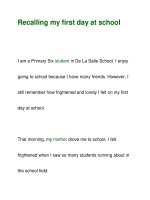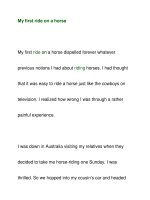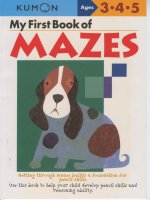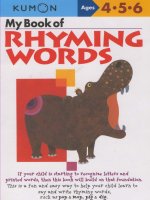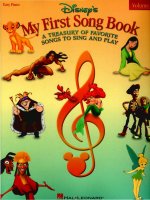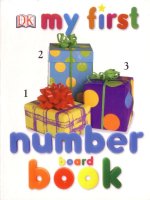my first britannica africa 8
Bạn đang xem bản rút gọn của tài liệu. Xem và tải ngay bản đầy đủ của tài liệu tại đây (8.33 MB, 97 trang )
CHICAGO LONDON NEW DELHI PARIS SEOUL SYDNEY TAIPEI TOKYO
MY FIRST BRITANNICA
Africa
8
© 2008 by Encyclopædia Britannica, Inc.
International Standard Book Number:978-1-59339-476-9 (set)
No part of this work may be reproduced or utilized in any form or by any means, electronic or mechanical,
including photocopying, recording, or by any information storage and retrieval system, without permission
in writing from the publisher.
My First Britannica:
Volume 8: Africa 2008
Britannica.com may be accessed on the Internet at .
Encyclopædia Britannica, Britannica, and the Thistle logo are registered trademarks of Encyclopædia Britannica, Inc.
Africa
TABLE OF CONTENTS
INTRODUCTION. . . . . . . . . . . . . . . . . . . . . . . . . . . . . . . . 5
Africa: Land of Splendor . . . . . . . . . . . . . . . . . . 6
Central and Western Africa
Congo: Two Countries, One Name. . . . . . . . . . . . . . . . . . . . 8
Ghana: Gold Coast of Africa . . . . . . . . . . . . . . . . . . . . . . . 10
Accra, Ghana: From Trading Post to Modern City . . . . . 12
Guinea: Forests and Minerals . . . . . . . . . . . . . . . . . . . . . 14
Liberia: Africa’s Oldest Republic . . . . . . . . . . . . . . . . . . . 16
Monrovia, Liberia: Freedom City. . . . . . . . . . . . . . . . . . 18
Nigeria: Land of 500 Languages . . . . . . . . . . . . . . . . . . . 20
Senegal: Land of
Teranga
. . . . . . . . . . . . . . . . . . . . . . . . 22
Dakar, Senegal: City of the Tamarind Tree . . . . . . . . . . 24
Eastern Africa
Ethiopia: Ancient Country in Africa’s Horn . . . . . . . . . . . 26
Addis Ababa, Ethiopia:
The City Called “New Flower” . . . . . . . . . . . . . . . . . 28
Kenya: Cradle of Humanity . . . . . . . . . . . . . . . . . . . . . . . 30
Nairobi, Kenya: From Swamp to Capital City . . . . . . . . 32
Seychelles: An Island Paradise . . . . . . . . . . . . . . . . . . . . 34
Somalia: Land of Nomads . . . . . . . . . . . . . . . . . . . . . . . . 36
Tanzania: Land of Natural Wonders . . . . . . . . . . . . . . . . 38
Uganda: Country of Lakes and Rivers . . . . . . . . . . . . . . . 40
Kampala, Uganda: City on the Hill of Antelopes . . . . . . 42
North Africa
Algeria: Desert Land on the Sea . . . . . . . . . . . . . . . . . . . 44
Algiers, Algeria: The Island City on the Hills . . . . . . . . 46
Egypt: The Pharaohs and the Pyramids. . . . . . . . . . . . . . 48
Egypt: Cultural Center, Past and Present . . . . . . . . . . . 50
Cairo, Egypt: City of the Nile. . . . . . . . . . . . . . . . . . . . . 52
Nile River: Egypt’s Gift. . . . . . . . . . . . . . . . . . . . . . . . . 54
Suez Canal: Joining Two Seas for a Shortcut . . . . . . . . 56
Libya: Oil Country of Africa . . . . . . . . . . . . . . . . . . . . . . . 58
Tripoli, Libya: Ancient Walled City . . . . . . . . . . . . . . . . 60
Rabat, Morocco: Built for Victory . . . . . . . . . . . . . . . . . . . 62
The Sudan: Giant of Africa . . . . . . . . . . . . . . . . . . . . . . . 64
Southern Africa
Angola: Land of Oil and Diamonds. . . . . . . . . . . . . . . . . . 66
Luanda, Angola: A Portuguese Legacy . . . . . . . . . . . . . 68
Botswana: The Jewel of the Kalahari. . . . . . . . . . . . . . . . 70
Madagascar: Island Sanctuary . . . . . . . . . . . . . . . . . . . . 72
Malawi: Lakeside Country . . . . . . . . . . . . . . . . . . . . . . . . 74
Lilongwe, Malawi: On Malawi’s Fertile Plains . . . . . . . 76
Namibia: A Beautiful, Arid Place . . . . . . . . . . . . . . . . . . . 78
Windhoek, Namibia: Namibia’s Windy Corner . . . . . . . 80
South Africa: Diamond Country . . . . . . . . . . . . . . . . . . . . 82
South Africa: A People Apart . . . . . . . . . . . . . . . . . . . . 84
South African Cities: Mixed Urban Histories. . . . . . . . . 86
Zimbabwe: From Colony to Independent Country . . . . . . . 88
Harare, Zimbabwe: City in a Garden. . . . . . . . . . . . . . . 90
Victoria Falls: “The Smoke That Thunders”. . . . . . . . . 92
GLOSSARY. . . . . . . . . . . . . . . . . . . . . . . . . . . . . . . . . . . 94
INDEX . . . . . . . . . . . . . . . . . . . . . . . . . . . . . . . . . . . . . . 95
Africa
In Volume 8,
Africa,
you’ll discover answers
to these questions and
many more. Through
pictures, articles, and
fun facts, you’ll learn
about the people,
traditions, landscapes,
and history that make
up many of the countries
and cities of Africa.
INTRODUCTION
Who were the pharaohs? What country was created as a home for freed slaves?
On what river would you find the Aswan High Dam?
What was apartheid?
To help you on your journey, we’ve provided the following guideposts in
Africa
:
■ Subject Tabs—The colored box in the upper corner of each right-hand
page will quickly tell you the article subject.
■ Search Lights—Try these mini-quizzes before and after you read the
article and see how much—and how quickly—you can learn. You can even
make this a game with a reading partner. (Answers are upside down at the
bottom of one of the pages.)
■ Did You Know?—Check out these fun facts about the article subject.
With these surprising “factoids,” you can entertain your friends, impress
your teachers, and amaze your parents.
■ Picture Captions—Read the captions that go with the photos. They
provide useful information about the article subject.
■ Vocabulary—New or difficult words are in bold type. You’ll find
them explained in the Glossary at the back of this volume. And there’s a
complete listing of all Glossary terms in the set in the Reference Guide
and Index, Volume 13.
■ Learn More!—Follow these pointers to related articles throughout the set.
■ Maps—You’ll find lots of information in this volume’s many maps.
■ The Country Maps point out national capitals. Globes beside Subject
Tabs show where countries are located in the world.
■ The Continent Maps have a number key showing the location of all
countries.
Cover photos (top): river running through Masai Mara National Reserve, Kenya, © Galen Rowell/Corbis; (center): Zimbabwean pots for sale at market, Johannesburg,
South Africa, © Neil Beer/Corbis; (bottom): Verreaux’s sifaka, South Africa, © Martin Harvey—Gallo Images/Corbis
MY FIRST BRITANNICA
Have a great trip!
■ The Icons on the maps highlight major geographic features and climate.
Here’s a key to what the map icons mean:
■ The Mini-Atlas, found in Volume 13, offers detailed maps, useful data
tables, and assorted photographs of each continent.
And don’t forget: If you’re not sure where to start, where you saw something
before, or where to go next, the Index at the back of this volume and the
Reference Guide and Index (Volume 13) will point the way.
Deserts and Other Dry Areas
Polar Regions and Other Frozen Areas
Mountains
Rainforests
General Forests
Verreaux’s sifaka, South Africa
© Martin Har vey—Gallo Images/Corbis
Alabaster sphinx at Memphis, Egypt.
© Roger Wood/Corbis
Giraffe, Kenya.
© Royalty-Free/Corbis
1
20
38
2
21
39
3
22
40
4
23
15
27
28
44
35
11
37
41
5
13
42
6
24
43
7
25
26
45
8
46
9
47
10
29
30
50
14
31
36
53
34
18
52
33
49
17
12
48
16
19
32
01. Algeria
02. Angola
03. Benin
04. Botswana
05. Burkina Faso
06. Burundi
07. Cameroon
08. Central African Republic
09. Chad
10. Comoros
11. Congo, Dem. Rep. of the*
12. Congo, Republic of the
13. Côte d’Ivoire
14. Djibouti
15. Egypt
16. Equatorial Guinea
17. Eritrea
18. Ethiopia
19. Gabon
20. Gambia
21. Ghana
22. Guinea
23. Guinea-Bissau
24. Kenya
25. Lesotho
26. Liberia
27. Libya
28. Madagascar
29. Malawi
30. Mali
31. Mauritania
32. Mayotte (France)
33. Morocco
34. Mozambique
35. Namibia
36. Niger
37. Nigeria
38. Rwanda
39. São Tomé and Príncipe
40. Senegal
41. Seychelles
42. Sierra Leone
43. Somalia
44. South Africa
45. Sudan
46. Swaziland
47. Tanzania
48. Togo
49. Tunisia
50. Uganda
51. Western Sahara†
52. Zambia
53. Zimbabwe
0
COUNTRIES OF AFRICA
2
51
* Full name is the Democratic Republic of the Congo (formerly Zaire)
† Annexed by Morocco
* Islands of Cape Verde, Mauritius, R
é
union off map
AFRICA
7
Answer: Africa is one of the largest continents.
★
L
a
n
d
o
f
S
p
l
e
n
d
o
r
Africa’s splendor is seen in its beautiful
landscapes, its amazing animal life, and its diverse
human culture. The African continent is the home of
more than 800 million people living in more than 50
countries. Africa is the second largest continent on
Earth, after Asia.
Africa’s long coastline is shaped by the Atlantic and
Indian oceans and the Mediterranean and Red seas. In
the north of the continent lies the Sahara. It is the world’s
largest desert and covers almost all of northern Africa. Located in
southwestern Africa are two other major deserts, the Kalahari and
the Namib.
The African continent has two major rivers, the Nile and the Congo.
The Nile is the longest river in the world. At the southern end of the Nile is
Lake Victoria, Africa’s largest lake. Not far to the southeast of Lake
Victoria is Mount Kilimanjaro, the highest point in Africa. One of the
world’s major waterfalls, Victoria Falls, is also in Africa.
Africa is known for its wildlife. There are elephants, rhinoceroses,
hippopotamuses, lions, and leopards. Other animals include antelope,
gazelles, giraffes, baboons, gorillas, hyenas, and chimpanzees. Most
of these animals live in Africa’s open grasslands or in tropical
rainforests.
The people of Africa belong to hundreds of ethnic groups. Each
group has its own language, traditions, religion, arts, and history.
During its political history, Africa has been the site of Egyptian
dynasties, African kingdoms, European colonies, and independent
countries.
L
EARN MORE! READ THESE ARTICLES…
ASIA (VOLUME 7) • CONTINENTS (VOLUME 1)
EUROPE (VOLUME 6)
Find and
correct the
error in the
following sentence:
Africa is one of the
smallest continents.
S
E
A
R
C
H
L
I
G
H
T
DID YOU KNOW?
Surprisingly, the coastline of Africa is
shorter than the coastline of Europe,
the second smallest continent. This is
because Africa has few inlets, large
bays, or gulfs—features that add to
coastal length by causing “detours”
away from a straight coastline.
8
Women gather firewood in the Democratic Republic
of the Congo, which is also called Congo (Kinshasa).
More than two-thirds of the people live in small towns
and villages.
© Gallo Images/Corbis
How
did the
Congo
get its name?
S
E
A
R
C
H
L
I
G
H
T
DID YOU KNOW?
The Congo River is one of the
great rivers of the world. Only the
Amazon River (in South America)
drains a larger area than the
Congo River does.
CONGO
9
As long as 25,000 years ago, people began to live in the
forests of the Congo River basin in west-central Africa.
They gathered food from the forests and dug up roots to eat.
Today the Congo basin contains two countries
separated by the Congo River. Both of the countries are
called Congo. To tell them apart, they are sometimes
referred to by the names of their capital cities. One of the
countries is called Congo (Brazzaville), and the other is
Congo (Kinshasa). Congo (Brazzaville) is officially
known as the Republic of the Congo. Congo (Kinshasa) is
officially called the Democratic Republic of the Congo.
The Congo region got its name from the Kongo, or Bakongo, one of
the main groups of people who live there. These people have been in the
area for centuries, from the time when the Congo was ruled by various
kingdoms.
The Portuguese arrived in the kingdom called Kongo in 1483. At first
the newcomers were friendly to the people of the kingdom. But by the
1530s the Portuguese were sending the Kongolese away as slaves.
By the late 1800s other European countries had become interested in
the Congo region. They valued the Congo River as a route for trade
between the west coast of Africa and the interior part of the continent. The
French and the Belgians took over different parts of the Congo. The local
people didn’t win their independence until 1960. Though free, each of the
two Congos faced many problems. Both countries
experienced periods of fierce internal fighting and
struggles for power.
Answer: It was named for the Kongo, or Bakongo, people, who
have lived there for centuries.
★
Congo (Brazzaville).
Congo (Kinshasa).
Brazzaville
Kinshasa
O
n
e
N
a
m
e
T
w
o
C
o
u
n
t
r
i
e
s
,
LEARN MORE! READ THESE ARTICLES…
AFRICA (VOLUME 8)
PORTUGAL (VOLUME 6)
RIVERS (VOLUME 1)
10
Why do you
think people
from so many other
countries wanted
to take over Ghana?
(Hint: Think of
Ghana’s former name.)
S
E
A
R
C
H
L
I
G
H
T
These miners work at the Ashanti gold mine in Obuasi,
Ghana. Ghana has long been one of the world’s leading
producers of gold. Mining provides work for many
of Ghana’s people.
© Penny Tweedie/Corbis
GHANA
11
The country of Ghana has so much gold that it was once
called the Gold Coast of Africa. It still has the largest gold
reserves in the world. Ghana is in western Africa. Accra
is its capital and largest city.
Ghana has coastal plains in the south, savanna in the north, and hills
and rainforests in between. The oddly shaped baobab tree grows in the
savanna and coastal plains. There you will also find giant anthills, some
of which are 14 feet high. In the rainforests are tall trees such
as the mahogany. And there are many kinds of animals—lions,
leopards, elephants, buffalo, monkeys, and snakes, to name
a few.
Many of Ghana’s people work in fishing, logging, or gold
mining. Farming is very important as well. Much of the
farmland is used for growing cacao. These trees produce cocoa
beans, which are used to make chocolate. Cacao, timber, and
gold are sold to other countries.
Long ago the Almoravids from northern Africa
conquered Ghana and forced its people to become slaves.
Since then, many other groups have gone to Ghana. The
Portuguese arrived in the 1400s. They traded in gold, ivory,
and slaves. Later came the British, the French, the Dutch, the Swedes, and
the Danes. In 1901 the British made the Gold Coast a colony. In 1957 the
colony won its independence and became the new country of Ghana. Today
Ghana is one of Africa’s leading democracies.
L
EARN MORE! READ THESE ARTICLES…
ACCRA,GHANA (VOLUME 8)
CACAO (VOLUME 10)
RAINFORESTS (VOLUME 1)
Answer: Ghana was called the Gold Coast because of its vast
reserves of gold. Many different people have wanted to control
Ghana over the years so that they could take its gold.
★
Accra
DID YOU KNOW?
Ghana’s weavers are famous for their
colorful kente cloth, which is made in
narrow strips in beautiful patterns. The
patterns have such names as
“thousand shields,” “the lion catcher,”
and “gold dust.” The strips are sewn
together to make clothing.
o
f
A
f
r
i
c
a
G
o
l
d
C
o
a
s
t
12
Accra is the capital of the West African country of Ghana. It lies on the
coast of the Gulf of Guinea, which is part of the Atlantic Ocean. The city is
built partly on a low cliff. The rest spreads northward across the Accra
plains.
Accra reflects the cultures of the many people who have settled in the
area where it now stands. The Ga people
had villages there when the Portuguese
arrived in 1482. The British, the Danes,
and the Dutch came later. The Europeans
built fortified trading posts along the
coast. They traded in gold, ivory, and
slaves. Because of the area’s gold, it
became known as the Gold Coast. In
1877 Accra became the capital of the
British Gold Coast colony.
The Gold Coast gained its
independence from British rule in 1957 and took the name Ghana. Accra
became the capital of the new country. Today it is a modern city of more
than 1.5 million people.
Accra is Ghana’s business and educational center. The national
museum and national archives and the Accra Central Library are located in
the city. The University of Ghana is in nearby Legon. Black Star Square is
the site of the Independence Arch. This large square is used for parades.
For those who like sports, Accra has a football (soccer) stadium and a
racecourse. Not far from Accra are the Aburi Botanical Gardens, which
were created by the British more than 100 years ago. And the
city’s large open markets receive most of the
food supply each day.
L
EARN MORE! READ THESE ARTICLES…
GHANA (VOLUME 8)
ROCKS AND MINERALS (VOLUME 1)
A STORY FROM GHANA:ANANSE AND
THE
WISDOM POT (VOLUME 5)
Children in Ghana enjoying a game called
mancala
,
played with stones and cups.
© Margaret Courtney-Clarke/Corbis
DID YOU KNOW?
Accra’s name comes from
nkran
, a
word in the language of the Akan
people of Ghana.
Nkran
are black
ants that are found all over the city
and the surrounding area.
F
r
o
m
T
r
a
d
i
n
g
P
o
s
t
t
o
M
o
d
e
r
n
C
i
t
y
Accra, GHANA
13
Answer: The British once ruled there.
Part of the city is built on a cliff.
★
Which of
the following can
be said of Accra?
a) The British once
ruled there.
b) It is located on the
Pacific Ocean.
c) Part of the city is
built on a cliff.
S
E
A
R
C
H
L
I
G
H
T
Accra lies along the Gold Coast, an area in southern Ghana that has rich
deposits of gold. The Portuguese built this strong fort, now called Elmina
Castle, in the Gold Coast in 1482. They wanted to keep all of the area’s
gold trade for themselves.
© Liba Taylor/Panos Pictures
14
Guinea is a country in western
Africa on the Atlantic Ocean. Its
capital city, Conakry, is a major
port. Ships stop there to load up on
Guinea’s minerals and other products and transport
them to markets around the world.
The land is divided into four main areas. A flat plain
lies along the coast. Northern Guinea has open grasslands called
savannas. The grass there grows as high as ten feet during the rainy season.
To the east the Fouta Djallon highlands rise sharply from the plain. In the
southeast is a hilly area with large forests. There are valuable teak,
mahogany, and ebony trees in this area. But much of the forest is becoming
open grassland. People have cut down many of the trees so that they can
use the land for farming.
Most people in Guinea work as farmers, growing their own food. They
grow rice, cassava, sweet potatoes, bananas, coffee, pineapples, peanuts,
yams, and corn. Some crops are grown for export, or to sell to other
countries. Guinea also has large amounts of such minerals as bauxite, iron
ore, gold, and diamonds. These are mined and exported.
The people of Guinea belong to several different groups. In the Fouta
Djallon region many people are Fulani. In northern Guinea are the
Malinke. Other major groups in the country are the Susu, the Kissi,
and the Kpelle. Until 1958 Guinea was a colony of France.
Because of that the official language in Guinea is French. But
many African languages are spoken there as well.
L
EARN MORE! READ THESE ARTICLES…
AFRICA (VOLUME 8) • ATLANTIC OCEAN (VOLUME 1)
ROCKS AND MINERALS (VOLUME 1)
Conakry
The savannas of northern Guinea have
some trees scattered among the grasses.
© David Reed/Panos Pictures
True
or false?
Most of the
people in Guinea
work as miners.
S
E
A
R
C
H
L
I
G
H
T
a
n
d
M
i
n
e
r
a
l
s
F
o
r
e
s
t
s
GUINEA
Answer: FALSE. Most of the country’s people are farmers.
★
DID YOU KNOW?
All three of western Africa’s major
rivers begin in Guinea. The country’s
Fouta Djallon region is the source of
the Niger, the Gambia, and the
Senegal rivers.
Women try to catch fish in a small pond north
of Monrovia, Liberia. Fish are a major source of
protein for many Liberians.
© Jan Dago/Magnum Photos
DID YOU KNOW?
Liberia means “land of the free,” a
fitting name for a country created for
freed slaves.
16
LIBERIA
17
In the 1820s some Americans who opposed slavery
bought land in West Africa. They used it to create a
new country for freed slaves, whose ancestors had
been taken from Africa. This country was called
Liberia. Its government was set up as a republic modeled on the United
States government. Liberia is now the oldest republic in Africa.
Despite the origins of the country, most of its citizens are not the
descendants of former slaves.
Today you can find out about Liberia’s past by visiting the
Malima Gorblah Village and Besao Village. These villages
preserve the country’s old culture. They are like living
museums of Liberia’s past.
Liberia’s climate is warm and humid all year and
rainy from May to October. The country’s forests and
rolling hills are home to such wild animals as
monkeys, chimpanzees, antelopes, elephants,
crocodiles, and poisonous snakes. There are two rare
animals found in Liberia. One is the pygmy
hippopotamus, which looks like a baby hippo even
when it’s full-grown. The other is the manatee, a big
seal-shaped mammal that lives in the water.
The rubber trees, coffee, and cocoa that grow in Liberia
provide products that can be sold to other countries. Liberian
farmers also grow rice, sugarcane, bananas, and yams. Liberia
is rich in mineral resources. It is one of the world’s leading
producers of iron ore.
Liberia suffered through a civil war in the early 1990s.
It made life dangerous and difficult for many people.
The war officially ended in 1996, but some fighting continued.
L
EARN MORE! READ THESE ARTICLES…
MANATEES (VOLUME 12)
MONROVIA,LIBERIA (VOLUME 8)
RAINFORESTS (VOLUME 1)
Answer: Liberia is the oldest republic in Africa.
★
Monrovia
Fill in
the blank:
Liberia
is the oldest
___________
in Africa.
S
E
A
R
C
H
L
I
G
H
T
O
l
d
e
s
t
R
e
p
u
b
l
i
c
A
f
r
i
c
a
’
s
18
DID YOU KNOW?
If you visit Monrovia, take
your umbrella. Monrovia is
the second wettest city in
the world! It gets more than
200 inches of rain every year.
Among the world’s cities,
only Buenaventura, Colombia,
gets more rainfall.
Where
does the name
Monrovia
come from?
S
E
A
R
C
H
L
I
G
H
T
As the capital of Liberia, the city of Monrovia is home
to the country’s most important government buildings.
The Executive Mansion (at the front of the photo) is
where the president lives.
© Albrecht G. Schaefer/Corbis
Monrovia, LIBERIA
19
Monrovia is the capital of Liberia, a country in western Africa. It is
also the largest city in the country. Monrovia is located on the coast, where
the Mesurado River meets the Atlantic Ocean. It is Liberia’s main port.
Monrovia is not as old as many other cities, but its short history makes an
interesting story of new beginnings.
A group known as the American Colonization Society founded the city.
They set up a whole new country so that freed slaves from the United
States could move to Africa, the home of their ancestors. Monrovia was
named after the U.S. president
James Monroe. He was the
president at the time Liberia
was founded.
The first settlement was
established in 1822. It later
developed into the city of
Monrovia. Liberia became an
independent republic in 1847, with
Monrovia as its capital. Most of the
settlers from the United States
arrived between 1830 and 1871. No longer enslaved, they were full of hope
for making a fresh start at life. Many people who already lived in Africa
also moved to Monrovia and to the other new towns in Liberia.
In 1851 the government of Liberia established a college in Monrovia.
That college, now called the University of Liberia, also has a medical
school. Today many people go to college in Monrovia.
A hospital in Monrovia is named after another U.S. president, John F.
Kennedy. Other important buildings in the city are the capitol, city hall,
and the Temple of Justice. But many of these buildings were damaged or
destroyed during Liberia’s civil war, which began in 1990. A truce was
declared in 1996, but some fighting continued.
L
EARN MORE! READ THESE ARTICLES…
ATLANTIC OCEAN (VOLUME 1) • LIBERIA (VOLUME 8) • SENEGAL (VOLUME 8)
Answer: Monrovia was named for the U.S. president at the time
Liberia was founded, President James Monroe.
★
Fishermen in Monrovia hauling in their nets.
© Eldad Rafaeli/Corbis
F
r
e
e
d
o
m
C
i
t
y
20
Nigeria is a country on the west coast of Africa. It’s a
place of great variety, in both land and people. More
people call Nigeria home than any other country on
the continent. There are about 250 different groups
of people living there. Each has its own traditions and ways of life. And
each group has its own language. More than 500 different languages
are spoken in Nigeria. But English is the official language.
The weather is not the same in all parts of the country.
Some areas get a lot of rain. Other areas are very dry.
Because there are different kinds of weather in different
parts of the country, there are many kinds of animals
and plants. There are thick rainforests as well as
mangrove and freshwater swamps. There is also
open grassland called “savanna.” There are small
trees all over the vast savanna.
DID YOU KNOW?
It is said that more twins are born in
Nigeria than anywhere else in the
world. Twins are so common that
they usually get the same set of
names. For example, the Yoruba
people usually name their twins
Taiwo and Kehinde.
L
a
n
d
o
f
5
0
0
L
a
n
g
u
a
g
e
s
NIGERIA
21
Once, camels, antelope, hyenas, lions, baboons,
and giraffes lived in the savanna. Red river hogs, forest
elephants, and chimpanzees lived in the rainforest.
Animals found in both forest and savanna included
leopards, monkeys, gorillas, and wild pigs. Today these
animals generally are found only in special parks.
Nigeria has many cities. The capital of Nigeria used to be Lagos.
But in 1991 the capital changed to Abuja. Lagos is a very large
coastal city with many businesses. But Abuja is in the middle of the
country, which makes it easier for people to travel there. Lagos was
overcrowded too, and Abuja had more open land for building.
Answer: FALSE. Parts of the country do get a lot of rain, but parts
of it are very dry.
★
Abuja
Wase Rock rises sharply above the surrounding
countryside near Wase, Nigeria. This part of the
country consists of savanna, or open grassland,
with scattered short trees.
© Bruce Paton/Panos Pictures
True
or false?
Nigeria
is a very
rainy country.
S
E
A
R
C
H
L
I
G
H
T
LEARN MORE! READ THESE ARTICLES…
AFRICA (VOLUME 8)
A NIGERIAN FOLKTALE:
THE MONKEY COURT (VOLUME 5)
WOLE SOYINKA (VOLUME 3)
22
The religion
followed by
most of the people
of Senegal is
a) Islam.
b) Christianity.
c) Buddhism.
S
E
A
R
C
H
L
I
G
H
T
A Soninke mother and child stand in the doorway of a traditional-
style mud house on a bank of the Senegal River. Like most of the
other peoples in Senegal, the Soninke are Muslim.
© Margaret Courtney-Clarke/Corbis
SENEGAL
23
Long ago there was a house packed with
men and women. They were inspected
and priced like animals. The weaker
ones died, and the stronger ones
were shipped to the Americas to work as slaves.
This slave house was on Gorée Island, which lies off
the coast of Senegal, in westernmost Africa. Exactly
what went on there is not known for sure. But Senegal
was at one time involved in selling Africans as slaves.
But that was long ago. Today Senegal’s culture is
known for its teranga, a spirit of warm welcome toward outsiders. Teranga
means “hospitality,” or “welcoming heart,” in the language of the Wolof.
Many different groups of people make up the Senegalese nation. The
Wolof are one of the largest of Senegal’s seven main ethnic groups.
Despite their different backgrounds, the people of Senegal tend to live
in similar ways. Most of the people practice Islam. And most live in small
villages in the countryside. Each village has a water source, a mosque, and
a public gathering place. France ruled Senegal until 1960. The different
groups of Senegal speak several different African languages, but French is
still widely used as a common language. This helps people from different
groups talk to each other.
Senegal is one of the world’s main producers of peanuts. The country
has wide rivers and good soil. The light-colored sandy soil in the
northwestern part of the country is especially good for growing peanuts.
Dakar, the country’s capital, is a major center for the
peanut trade.
L
EARN MORE! READ THESE ARTICLES…
DAKAR,SENEGAL (VOLUME 8) • ISLAM (VOLUME 5)
PEANUTS (VOLUME 10)
Answer: a) Islam.
★
L
a
n
d
o
f
T
e
r
a
n
g
a
Dakar
DID YOU KNOW?
Léopold Senghor, the first president
of independent Senegal, was also an
important writer. He was a leading
poet of a movement that celebrated
African culture.
24
The small island of Gorée, near Dakar, served as an
outpost for slave trading for some three hundred years.
Slavery became illegal in Senegal in 1848, and the trading
post closed. Today, tourists come to Gorée to visit several
museums and the remains of old forts.
© Marcel & Eva Malherbe/The Image Works
DID YOU KNOW?
Dakar is at the heart of Senegal’s
thriving music scene. One of the city’s
most famous musicians is Youssou
N’Dour. His songs blend a wide range
of styles, from traditional African
music to Cuban rhythms, Western
pop, jazz, and soul.



